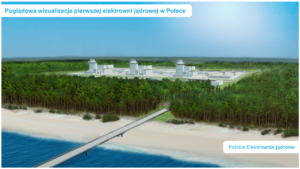The LOTOS capital group, which may soon become part of PKN Orlen has recently completed the feasability study for the construction of a small-scale LNG terminal in Gdańsk. The next step is making an investment decision. The goal of this project is to enable the usage of LNG in road and maritime transport. This decision may be made by the company’s new owner – PKN Orlen. However, contrary to the LNG terminal in Świnoujście and the planned floating LNG unit in Gdańsk, whose goal is to ensure security of supply, LOTOS’s small-scale terminal is to increase competition on the LNG market in Poland and in the Baltic Sea – writes Bartłomiej Sawicki, editor at BiznesAlert.pl.
Ideas behind the project
The LOTOS group is considering building a small-scale LNG terminal in Gdańsk as part of a consortium with GAZ-SYSTEM, Poland’s gas grid operator. It will be an LNG handling and logistics depot. From there the gas will be delivered to service stations, ships for bunkering or off-grid facilities (i.e. areas where there is no access to the gas grid).
The investment encompasses, among others, the construction of an LNG storage tank, a loading and unloading system for the vessel station, pumping facilities for ships, and pumping facilities for road tankers and containers. The terminal’s total capacity may exceed 3,000 cubic meters. The project’s goal is to analyze the possibility of entering the promising market of LNG handling and bunkering. Developing Poland’s import abilities opens a very real possibility of it becoming a regional center for handling and supplying LNG. The LNG base in Gdańsk could become an important link in the hub’s supply chain.
The venture is co-financed by the European Union under the Connecting Europe Facility, which was established to develop trans-European transport, energy and telecommunications networks. Investing in infrastructure may increase competitiveness and economic, social and territorial cohesion. GAZ-SYSTEM’s role in the endeavor is to advise LOTOS on implementing the project and acquiring EU funds.
Market prognosis
Since LNG offers a lot of potential as maritime fuel and as power and heat generator, it plays well with decarbonization policies, which is why it will become increasingly popular in the coming years. According to an an analysis by Energias Market Research, the demand for the so-called small-scale LNG market in the Baltics will each 1.908 MTPA by 2030 with an estimated CAGR (Compound Annual Growth Rate – ed.) of 14.01% from 2020 to 2030. Increased investments in LNG infrastructure in the Baltic Sea region, as well as support from local governments to adopt LNG as maritime and land transport fuel may be the driving forces behind developing this market. Another contributing factor is the cap on sulphur emissions for maritime and road fuel set by the European Union.
Small-scale LNG terminal in Gdańsk
In Poland the LNG market has been so far treated as an alternative to Russian gas, which means it has been perceived through the lens of energy and supply security. This mostly pertains to the LNG terminal in Świnoujście, which, after its expansion will increase its capacity to 8.3 bcm of gas a year at the beginning of 2024. GAZ-SYSTEM, which operates the terminal as Polskie LNG, is also planning to construct a floating re-gasification unit in the Gulf of Gdańsk. The facility’s capacity would be 4.5 bcm annually and it would be completed in 2025.
Whereas, the LOTOS Capital Group is planning to build a technically and commercially different facility, i.e. a small-scale LNG terminal in Gdańsk, offering LNG handling, bunkering and distribution services to regional harbors, main transport networks and areas in Poland without access to the gas grid.
The Group’s current strategy is to diversify its business by investing in alternative fuels, such as LNG, CNG, electricity and hydrogen. As part of this strategy, LOTOS is verifying whether it should invest in constructing a small-scale LNG terminal that will serve as a hub for handling, bunkering and distributing LNG for end-users and petrol stations.
The project in question is related to the plans to expand LNG re-gasification and handling at the terminals in Świnoujście and Gdańsk. Enlarging the LNG terminal in Świnoujście and constructing the floating re-gasification unit in Gdańsk, offer a real opportunity to create an LNG handling and distribution market in Poland and the region. LOTOS’s LNG facility in Gdańsk, could become a significant link in the hub’s supply chain. LOTOS’s LNG facility in Gdańsk, could become a significant link in the hub’s supply chain. The direct vicinity of harbors in Gdynia and Gdańsk make this location a very good option. Those ports could become one of the key buyers of LNG used for bunkering ships that run on this fuel.
Moreover, an LNG base in Gdańsk could also supply those regions in Poland where there is no access to the gas grid, mostly communes located in northern and north-eastern part of the country, which are further away from the LNG terminal in Świnoujście than from the LNG facility that may be built in Gdańsk. According to estimates, the demand for LNG from the facility may oscillate between 29 and 472 thousand cm a year. LOTOS says that the target value may exceed 472 thousand cm in 2040.
The key factor that will heavily impact the facility’s competitiveness will be the fuel supplier. Therefore, it seems that the recommended LNG supplies should be delivered via the terminal in Świnoujście via small vessels with a capacity of 10 thousand cm, once the second jetty which will offer LNG handling services is completed.
Depending on the market segment, a few or over a dozen rivals will compete against this project. The biggest market share may be expected with regard to LNG deliveries for trucks and ship bunkering. However, considering the tough competition with regard to supplying LNG to power and heat generation facilities, the project’s competitive position may be hard.
LOTOS’s plan is to develop the investment in stages – first up to a capacity of 5 thousand cm, and then, depending on how the business will grow, up to 10 thousand cm. Analyses of market practices show that in countries where the LNG market is small and where there is no need for re-gasification services, stationery storage facilities and small terminals are built with a capacity of up to 15 thousand cm. At the same time, the analyses on LNG demand from the LOTOS facility in Gdańsk show the expected demand is extremely varied and depends on how the market and competition will grow. LOTOS believes this investment should be split into stages, as it will have to face a number of difficulties, including the underdeveloped market of maritime vessels and road vehicles that run on LNG, as well as pressure from other terminals, such as Lithuania’s floating unit located in Klaipeda. Therefore, the first stage would involve the construction of five containers each 1,000 cm in horizontal pressure containers. In the second one ten containers each 1,000 cm will be built in horizontal pressure containers to reach a capacity of 15,000 cm in total. Whether the second stage would be implemented or not would depend on the growth of demand for LNG in Poland, or on plans to widen the facility’s scope by adding re-gasification services.
PKN Orlen’s new business line?
At the end of July the European Commission is set to issue its decision on the acquisition of LOTOS by PKN Orlen. According to Reuters, the decision will be positive provided the company from Płock will fulfill the EC’s conditions. PKN Orlen wants to be an energy conglomerate. If Orlen takes over LOTOS, it will enter a new market – the Baltic Sea. Considering the proximity of the floating storage re-gasification unit in Gdańsk, such a facility could become an obvious supplier of fuel for Orlen’s new business line, i.e. LNG for ships and trucks. If oil demand drops in the coming years, LNG may become an „interim fuel” for Orlen on the company’s way to the „oil of the future”, which may be hydrogen. PKN Orlen’s venture into the small-scale LNG market seems even more probable considering PGNiG, another energy giant from Poland which also wants to become an energy conglomerate, since 1 of August 2020 has been the sole user of Lithuania’s small LNG reloading station in Klaipeda. The coming weeks will show whether LOTOS from the PKN Orlen Group will become a multi-energy concern in Gdańsk.








